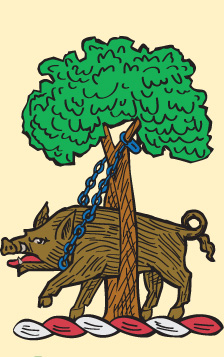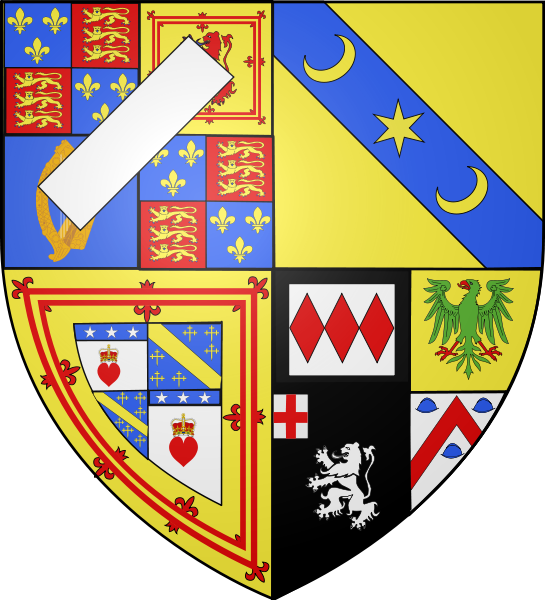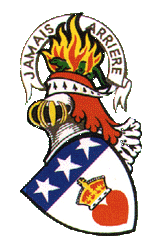Coat of arms
WORK IN PROGRESS
Coat of arms
 A
coat of armsA
coat of arms is a unique heraldic design on a shield or escutcheon
or on a surcoat or tabard used to cover and protect armour and to
identify the wearer. Thus the term is often stated as "coat-armour",
because it was anciently displayed on the front of a coat of cloth.
(Image, left:
Archibald Douglas 'Bell the Cat', 5th Earl of Angus) The
coat of arms on an escutcheon forms the central element of the full
heraldic achievement which consists of shield, supporters, crest and
motto. The design is a symbol unique to an individual person, and to
his family, corporation, or state. Such displays are commonly called
armorial bearings, armorial devices, heraldic devices, or simply
armorials or arms.
A
coat of armsA
coat of arms is a unique heraldic design on a shield or escutcheon
or on a surcoat or tabard used to cover and protect armour and to
identify the wearer. Thus the term is often stated as "coat-armour",
because it was anciently displayed on the front of a coat of cloth.
(Image, left:
Archibald Douglas 'Bell the Cat', 5th Earl of Angus) The
coat of arms on an escutcheon forms the central element of the full
heraldic achievement which consists of shield, supporters, crest and
motto. The design is a symbol unique to an individual person, and to
his family, corporation, or state. Such displays are commonly called
armorial bearings, armorial devices, heraldic devices, or simply
armorials or arms.
Historically, armorial bearings were first
used by feudal lords and knights in the mid-12th century on
battlefields as a way to identify allied from enemy soldiers. As the
uses for heraldic designs expanded, other social classes who never
would march in battle began to assume arms for themselves.
Initially, those closest to the lords and knights adopted arms, such
as persons employed as squires that would be in common contact with
the armorial devices. Then priests and other ecclesiastical
dignities adopted coats of arms, usually to be used as seals and
other such insignia, and then towns and cities to likewise seal and
authenticate documents. Eventually by the mid-13th century,
peasants, commoners and burghers were adopting heraldic devices. The
widespread assumption of arms led some states to regulate heraldry
within their borders. However, in most of continental Europe,
citizens freely adopted armorial bearings.
Despite no
widespread regulation, and even with a lack in many cases of
national-level regulation, heraldry has remained rather consistent
across Europe, where traditions alone have governed the design and
use of arms. Unlike seals and other general emblems, heraldic
achievements have a formal description called a blazon, expressed in
a jargon that allows for consistency in heraldic depictions.
In the 21st century, coats of arms are still in use by a variety of
institutions and individuals; for example, universities have
guidelines on how their coats of arms may be used, and protect their
use as trademarks. Many societies exist that also aid in the design
and registration of personal arms, and some nations, like England
and Scotland, still maintain to this day the mediæval authorities
that grant and regulate arms.
Escutcheon (shield)
In heraldry, an escutcheon is a shield which forms the main or focal
element in an achievement of arms. The word is used in two related
senses.
Firstly, as the shield on which a coat of arms is
displayed. Escutcheon shapes are derived from actual shields used by
knights in combat, and thus have varied and developed by region and
by era. As this shape has been regarded as a war-like device
appropriate to men only, British ladies customarily bear their arms
upon a lozenge, or diamond-shape, while clergymen and ladies in
continental Europe bear theirs on a cartouche, or oval.
The Shield of Douglas is a characteristic example of the gradual
development of armorial composition. About A.D. 1290, the Seal of
William, Lord Douglas, displays his Shield, No. 155, bearing—Arg.,
on a chief az. three mullets of the field. Next, upon the field of
the Shield of William, Lord Douglas, A.D.1333, there appears, in
addition, a human heart gules, as in No. 156. And, finally, the
heart is ensigned with a royal crown, as in No. 157, this form
appearing as early as 1387.

 The
Boar is an animal which, with its parts, will constantly be met with
in British armory (Figs. 353-355). Theoretically there is a
difference between the boar, which is the male of the domestic
animal, and the wild boar, which is the untamed creature of the
woods. Whilst the latter is usually blazoned as a wild boar or
sanglier, the latter is just a boar; but for all practical purposes
no difference whatever is made in heraldic representations of these
varieties, though it may be noted that the crest of Swinton is often
described as a sanglier, as invariably is also the crest of Douglas,
Earl of Morton [" A sanglier sticking between the cleft of an
oak-tree fructed, with a lock holding the clefts together all
proper"]. The boar, like the lion, is usually described as armed and
langued, but this is not necessary when the tusks are represented in
their own colour and when the tongue is gules. It will, however, be
very frequently found that the tusks are or. The "armed," however,
does not include the hoofs, and if these are to be of any colour
different from that of the animal, it must be blazoned "unguled" of
such and such a tincture. Precisely the same distinction occurs in
the heads of boars (Figs. 356-358) that was referred to in bears.
The real difference is this, that whilst the English boar's head has
the neck attached to the head and is couped or erased at the
shoulders, the Scottish boar's head is separated close behind the
ears. No one ever troubled to draw any distinction between the two
for the purposes of blazon, because the English boars' heads were
more usually drawn with the neck, and the boars' heads in Scotland
were drawn couped or erased close. But the boar's head in Welsh
heraldry followed the Scottish and not the English type. Matters
armorial, however, are now cosmopolitan, and one can no longer
ascertain that the crest of Campbell must be Scottish, or that the
crest of any other family must be English; and consequently, though
the terms will not be found employed officially, it is just as well
to distinguish them, because armory can provide means of such
distinction--the true description of an English boar's head being
couped or erased "at the neck," the Scottish term being a boar's
head couped or erased "close."y a boar's head
will be stated to be borne erect; this is then shown with the mouth
pointing upwards. A curious example of this is found in the crest of
Tyrrell: "A boar's head erect argent, in the mouth a peacock's tail
proper."
The
Boar is an animal which, with its parts, will constantly be met with
in British armory (Figs. 353-355). Theoretically there is a
difference between the boar, which is the male of the domestic
animal, and the wild boar, which is the untamed creature of the
woods. Whilst the latter is usually blazoned as a wild boar or
sanglier, the latter is just a boar; but for all practical purposes
no difference whatever is made in heraldic representations of these
varieties, though it may be noted that the crest of Swinton is often
described as a sanglier, as invariably is also the crest of Douglas,
Earl of Morton [" A sanglier sticking between the cleft of an
oak-tree fructed, with a lock holding the clefts together all
proper"]. The boar, like the lion, is usually described as armed and
langued, but this is not necessary when the tusks are represented in
their own colour and when the tongue is gules. It will, however, be
very frequently found that the tusks are or. The "armed," however,
does not include the hoofs, and if these are to be of any colour
different from that of the animal, it must be blazoned "unguled" of
such and such a tincture. Precisely the same distinction occurs in
the heads of boars (Figs. 356-358) that was referred to in bears.
The real difference is this, that whilst the English boar's head has
the neck attached to the head and is couped or erased at the
shoulders, the Scottish boar's head is separated close behind the
ears. No one ever troubled to draw any distinction between the two
for the purposes of blazon, because the English boars' heads were
more usually drawn with the neck, and the boars' heads in Scotland
were drawn couped or erased close. But the boar's head in Welsh
heraldry followed the Scottish and not the English type. Matters
armorial, however, are now cosmopolitan, and one can no longer
ascertain that the crest of Campbell must be Scottish, or that the
crest of any other family must be English; and consequently, though
the terms will not be found employed officially, it is just as well
to distinguish them, because armory can provide means of such
distinction--the true description of an English boar's head being
couped or erased "at the neck," the Scottish term being a boar's
head couped or erased "close."y a boar's head
will be stated to be borne erect; this is then shown with the mouth
pointing upwards. A curious example of this is found in the crest of
Tyrrell: "A boar's head erect argent, in the mouth a peacock's tail
proper."
Woodward mentions three very strange coats of arms
in which the charge, whilst not being a boar, bears very close
connection with it. He states that among the curiosities of heraldry
we may place the canting arms of Ham, of Holland: "Gules, five hams
proper, 2, 1, 2." The Verhammes also bear: "Or, three hams sable."
These commonplace charges assume almost a poetical savour when
placed beside the matter-of-fact coat of the family of Bacquere:
"d'Azur, à un ecusson d'or en abîme, accompagné de trois groins de
pore d'argent," and that of the Wursters of Switzerland: "Or, two
sausages gules on a gridiron sable, the handle in chief."
 |
|
The coat of arms (above) of the 5th Duke of Buccleuch, is made up of the following heraldic charges:
 |
 |
 |
 |
 |
 |
 |
 |
| Bend
between |
Bend, on
a, between |
Bordure |
Chief, on
a |
Coronet,
ducal, out of |
Crescents
(2) |
Cross
crosslets (6) |
Crown,
imperial |
 |
 |
 |
 |
 |
 |
 |
|
| eagle
displayed |
France
and England |
Heart |
Lozenges |
Mullet |
Mullets
(3) |
Stag
trippant |
|
Any contributions will be
gratefully accepted
Errors and Omissions
We are looking for your help to improve the accuracy of The Douglas
Archves
If you spot errors, or omissions, then please do
let us know.
The Forum
If you have met a brick wall with your research, then posting a
notice in the Douglas Archives Forum may be the answer. Or, it may
help you find the answer!
You may also be able to help others answer their queries.
Visit the
Douglas Archives Forum.
What's New?
We try to keep everyone up to date with new entries, via our
What's New section on the
home page.
We also use
the blog to keep researchers abreast of developments in the
Douglas Archives.


